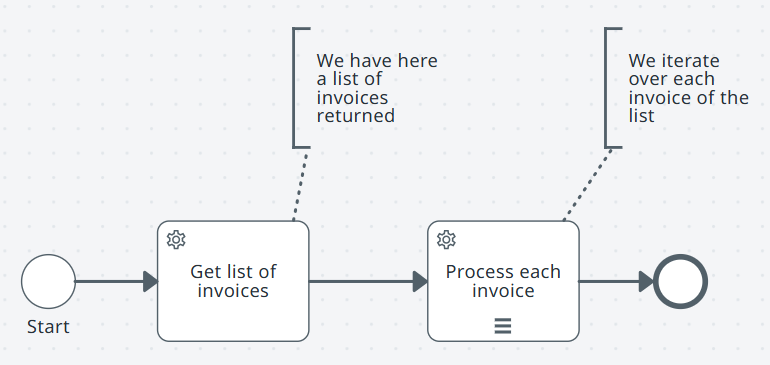maestro
latest
false
- Introduction
- Getting started
- Process modeling
- Process implementation
- Process operations
- Process monitoring
- Process optimization
- Reference information

Maestro user guide
Last updated Dec 12, 2025
Looping
Same task over a list, one by one (sequential multi‑instance)
Note:
Related configuration: read Multi‑instance execution for collection, item alias, and aggregation.

Use when
- Tasks must occur in order.
- Each step depends on a prior result.
- Sequence integrity matters.
Pattern in simple words
-
Start.
-
Service task with sequential multi‑instance: Reconcile transaction over the collection.
-
End All reconciled.
Note:Sequential mode preserves order.
Other scenarios
- Finance: Post invoice lines in sequence.
- Insurance: Review claims in received order.
- Healthcare: Process test results per patient.
- Retail: Approve store returns sequentially.
- Manufacturing: Inspect items per batch.
Same task over a list, all at once (parallel multi‑instance)

Use when
- Items are independent.
- Items are independent
- Order does not affect outcome.
Pattern in simple words
-
Start.
-
Service task with parallel multi‑instance: Run security scan for each server in the collection.
-
User task: Review results.
-
End Scan complete.
Note:Use aggregation to collect per‑item outputs.
Other scenarios
- Finance: Client credit checks simultaneously.
- Insurance: Evaluate multiple policies in parallel.
- Manufacturing: Inspect multiple lines concurrently.
- Retail: Update store prices at once.
- Public sector: Review permits across districts together.
Nested repetition inside a subprocess

Use when
- Two levels of iteration exist, such as batch and item.
- You need a clean structure that keeps loops organized.
Pattern in simple words
-
Start.
-
Subprocess with sequential multi‑instance: Inspect batch, one batch at a time.
- Inside the subprocess: Service task with parallel multi‑instance: Inspect item for each item in the batch.
-
End Batch complete.
Note:Use sequential outer and parallel inner when batches must not overlap.
Other scenarios
- Finance: Process monthly statements with multiple entries.
- Healthcare: Audit patients by department.
- Retail: Reconcile store sales by region.
- Manufacturing: Audit batches by product line.
- Insurance: Review claims by policy group.